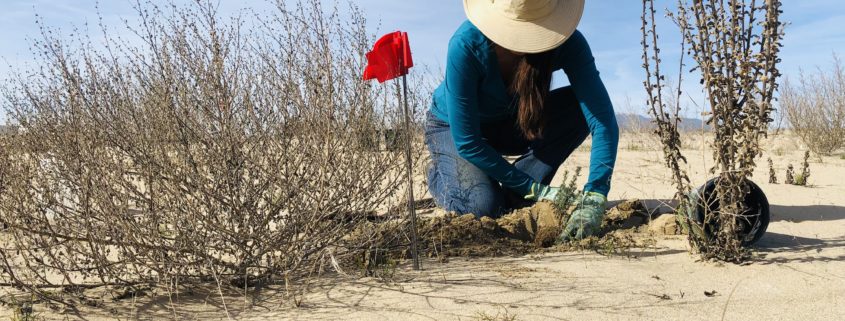
The disappearing Colton dunes, found only in the Inland Empire, get a helping hand from the community.
Originally stretching forty square-miles from Ontario to Colton, the rare Colton dunes are rapidly diminishing. With just over 400 acres under permanent conservation, stewardship of the remaining habitat is critical to the flora and fauna that reside there.
In the past five years spent tending this habitat, I’ve learned that it takes a community to succeed. Not only does it take countless hours of sweat-equity from volunteers and staff, but also the endless collaboration and sharing of knowledge between the few land managers and agencies with the shared goal of restoring the land to what we interpret to be its natural condition. We’re all just learning as we go. I know I am.
Although dunes appear to be dry desolate wastelands lacking signs of life, they are often hotspots for biodiversity. Nutrient poor soil, high-wind exposure, minimal shade cover and searing summer temperatures may seem inhospitable, but these environmental pressures create diamonds in the form of sand-loving plants, arthropods and the predators that eat them.
The resilient native California buckwheat, deerweed and primrose aren’t the only plants that flourish in the harsh conditions of the Colton dunes. Unfortunately, invasive brome grasses and mustard species create dense thatch. This stabilizes the once undulating landscape where the horned lizards scurried uninhibited across the bare sand.
I’ve searched for historic photographs, drawings or accounts of the habitat in its original state. Struggling to find information, I reached out to the community for anecdotes. Although I didn’t uncover solid data on the natural resources, I did discover the community’s love for the dunes. Shared experiences in what the locals called the “sand hills” included catching lizards, off-roading, cutting class and drinking a cold brew in the sun. None of this may seem beneficial to landscape conservation, but connection to wild places has a positive impact and surprisingly, so can off-roading.
Off-road vehicle activity in the dunes inspired a method of restoration. In 2015, Jonathan Reinig, Natural Resource Manager at the Western Riverside County Regional Conservation Authority (RCA), noticed that historic off-road vehicle tracks had created patches of bare sand with minimal non-native plant species.
At the RCA’s Teledyne Preserve near Fontana, Reinig took this concept and rolled with it. Utilizing an ATV, he created bare paths in the sand between more dense patches of native vegetation. Eventually Jonathan put his welding skills to work and created a harrow. Employing this weighted drag tool with teeth or tines used to break up the soil, he was able to find a cost-effective method of removing weeds. The harrow drag method worked well and we apply this method at other sand dune preserves.
But there is a delicate balance. Historic uncontrolled off-road use has also created large swaths of barren sand devoid of any vegetation. As a result, Santa Ana winds gusting in from the Cajon Pass are blowing sand away faster than it is being replaced. Our early attempts to slow the winds and establish native vegetation were unsuccessful but once again, the community came to the rescue.
Alejandra Soto, Assistant Restoration Project Manager at California Botanic Garden in Clairmont, CA shared her experience restoring the coastal sand dunes at LAX airport. Soto used wooden cedar shims staked into the sand in a random matrix to resist sand loss and promote plant growth. The method was developed by Safe Harbor Environmental in Cape Cod, MA to protect coastal sand dunes from being washed away in the Atlantic Ocean. The shims mimic small plants that would provide root structure and turbulence promoting sand deposition. We started using this method at Rivers & Lands Conservancy’s Boruchin Preserve in 2021. So far, the shims seem to be promoting revegetation on the downwind side of the installation areas.
On January 28th, the community came together to install an additional five-hundred shims in the Preserve, plantings, and to remove dumped waste. Originally planned for thirty volunteers, a quickly growing waitlist for the event showed us the need to increase capacity. We were happy to accommodate.
Every time new volunteers visit the sand dune preserves; they can’t seem to believe they exist. Perhaps if they inquired with past generations about our “sand hills”, they might learn the storied hostory of riding motorcycles, searching for lizards and good old-fashioned high school debauchery.
Just as the Colton dunes need community-based restoration, conservation is reliant on the community’s connection with the dunes. So many of the next generation of stewards have yet to create positive memories linking them to the landscape. They’ve yet to feel the fine grain sand, smell the sweet croton leaves, or see the darkling beetles aimlessly wandering the sea of sand. We want to inspire conservation, but no one will conserve what they do not know is there.
Rivers & Lands Conservancy connects our community to natural, wild, and open spaces of Southern California through land conservation, stewardship, and education.
Michael Viramontes is the Stewardship Manager of Rivers & Lands Conservancy, has a B.S in Environmental Studies and Natural Resource Management from San Jose State University.





